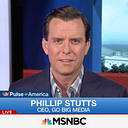I Tried Going Negative With My Advertising — and It Actually Worked. Here’s What I Learned
When it comes to marketing, negativity or comparison advertising, can be a slam-dunk if you’re trying to disrupt your competition in the marketplace.
I recently sat down with Melissa Thompson of Inc. to talk about my book Fire Them Now. I hope you enjoy her write up about a chapter in my book called Going Negative!
We hear a lot about the power of positivity. Have you ever stopped to think about the power of negativity? This typically shows up in the form of political attack ads, but recently I’ve been experimenting with how I can use the power of negative and comparison advertising to support the growth of my own digital marketing.
At my company, thinking like an underdog both creates a drive within the company to innovate and also attracts a following of consumers who want to see us win and may even want to be a part of our win. We saw this happen specifically when a larger company sued us and it made local headlines. Many of our customers expressed their support, and when we finally won, we saw a bump in sales from new customers, referred by friends who had been backing us the whole time.
I sat down with Phillip Stutts, author of the upcoming book, Fire Them Now — The 7 Lies Digital Marketers Sell (and the Truth about Political Strategies That Help Businesses Win) to talk about the art of going negative in the world of political and corporate digital marketing.
Going negative in a strategic and targeted manner, has been a huge competitive advantage for my business. It’s an outlier strategy that has increased my market share and continues to grow my consumers year after year.
Here’s what I discovered.
Comparison, Not Annihilation
Turns out, most of my customers will root for my company when I position myself as the underdog trying to knock out my biggest competitors. Thinking like an underdog both creates a drive within my company to innovate and also attracts a following of consumers who want to see me win and may even want to be a part of my winning growth story.
I have found that the common misconception that leads other CEOs and business owners away from comparison advertising is the (incorrect) assumption that you have to go full mud slinging, abandon all taste, and totally disparage your competition. That’s not what I’m talking about.
In today’s ‘don’t rock the boat’ business culture, my fellow CEOs are so afraid to run comparison ads on their competitors that they won’t even consider the strategy. What are they so afraid of?
“It’s not about total annihilation,” Stutts revealed to me, “It’s about carefully using the power of comparison to create underdog status with consumers, engage with your audience, build your following, and ultimately craft an environment where a customer draws their own negative conclusions about your competitor, and chooses you, all by themselves.”
Recently, my team carefully used the power of comparison to create underdog status with consumers similar to the “Avis, We Try Harder” campaign. This allowed us to engage with our audience, build our following, and ultimately craft an environment where our customers draw their own negative conclusions about my largest competitor, and chooses our company, all by themselves.
Other companies, like Puregold, use their history in the gold industry as a competitive advantage over other blockchain competitors. In the eyes of traditional gold conglomerates PureGold remains an underdog. This unique position gives them the chance to play both sides as they compete.
It’s About ROI
When looking to increase profile and brand awareness, I’ve found that going negative is a smart, lean, cost-effective solution, that can yield substantial results. When it comes to digital marketing, we’ve all been taught that differentiation and unique selling propositions are what allows us to stand out, become associated with the category and move to the first consideration when someone is thinking about making a purchase decision. For some brands, like Sparkle Coin, this means creating effective marketing and messages on the value provided to consumers, while not hiding some challenges. By giving value you first, you leverage the potential for a higher ROI later down the line.
To illustrate this point, think about T-Mobile’s recent strike at Verizon, with a single tweet. T-Mobile’s smart and adept CEO, John Legere, tweeted an article that showed that T-Mobile customers are more loyal than Verizon’s, Sprint’s, or AT&T’s. He appended the article with the following line:
Notice how he only called out the biggest competitor, Verizon? He didn’t mention Sprint or AT&T. There was no need — the press picked up the story did all that work for him. That’s what I’m talking about, and it’s a strategy that is highly underutilized in my opinion.
Turning Negative Advertising Into Positive Results
The bottom line is that negativity works. But, as Stutts emphasized, it has to be comparison advertising with finesse, a certain flair, and creativity — especially for a company trying to disrupt their market and its more established competitors.
Going negative with this delicate formula will help position your company as the underdog, attract fans that root for you, and yield big returns. Give it a shot and you’ll see what I’m talking about. Once you realize the power this strategy yields, you’ll find all sorts of creative ways to leverage it for your growth.
